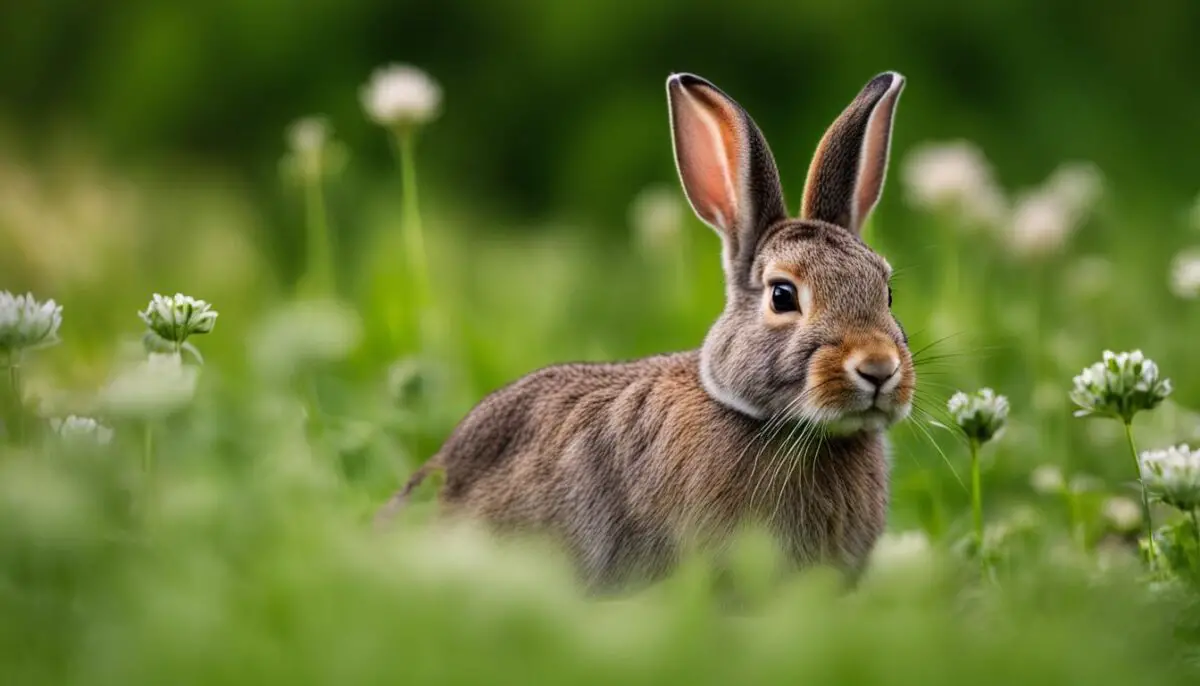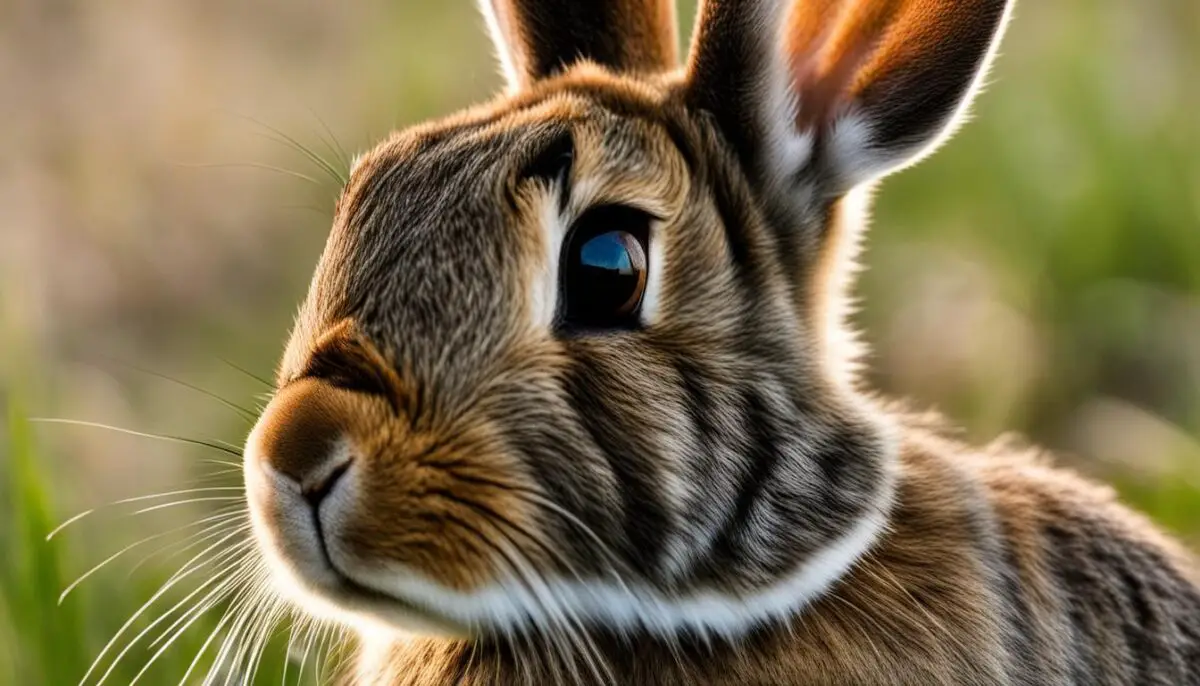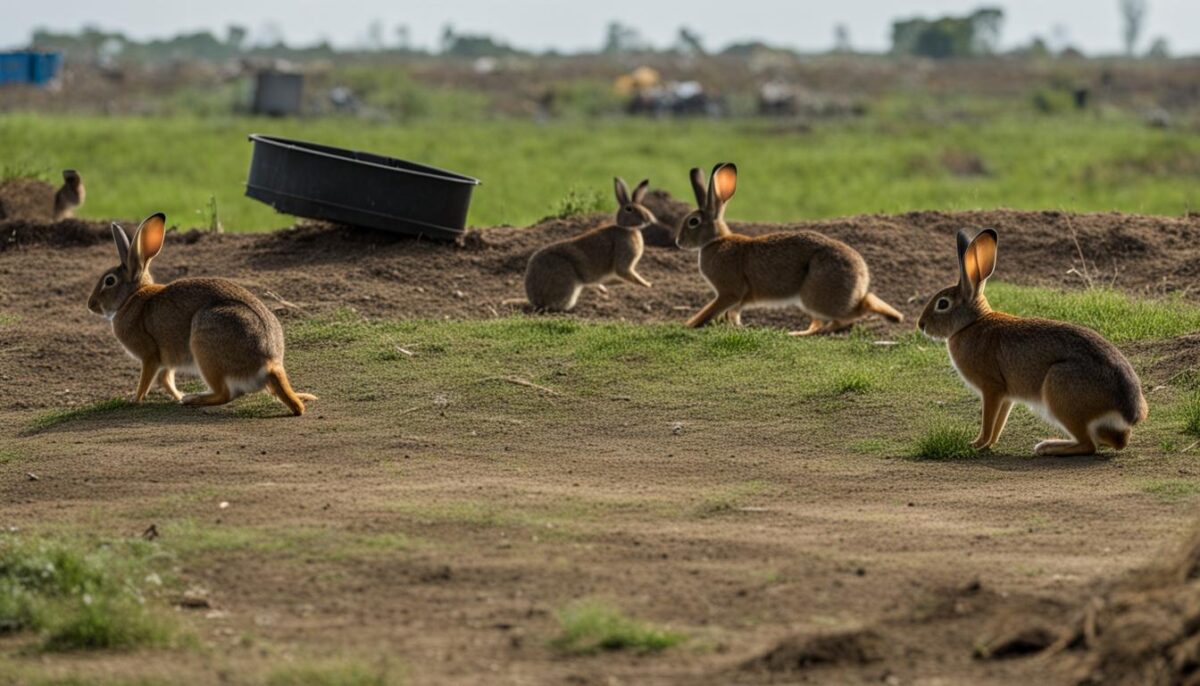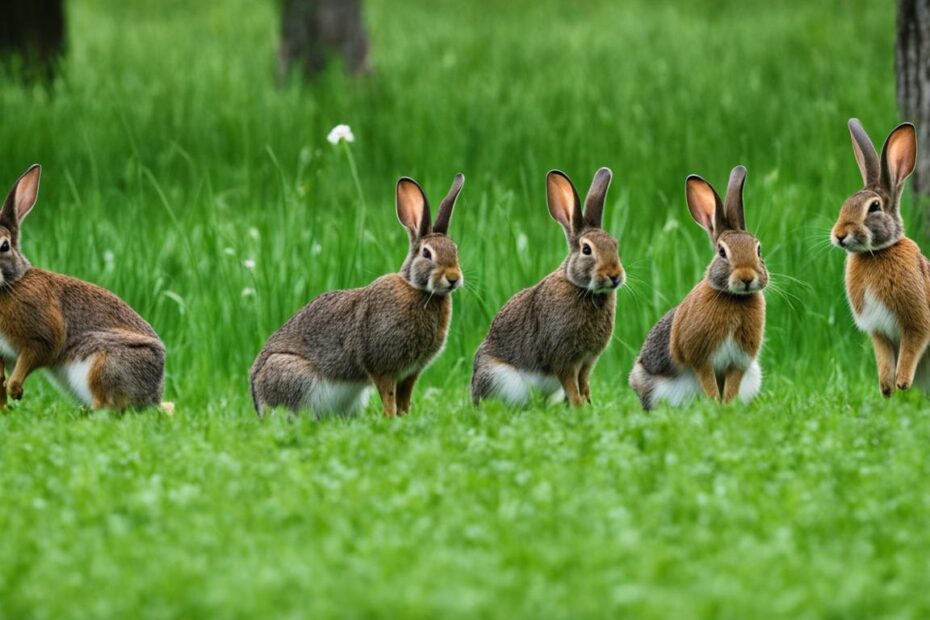Welcome to our exploration of wild rabbits in Massachusetts! In this article, we will delve into the fascinating world of these furry creatures and provide you with valuable insights on their habitat, species, and how to identify them in the wild.
Massachusetts is home to a diverse range of wild rabbit species, but there are two prominent ones that inhabit this region—the native New England Cottontail and the non-native Eastern Cottontail. These adorable creatures have adapted well to human-populated habitats, making their homes in farmland, suburban yards, and even unexpected places like isolated weedy patches in the middle of cities.
Now, let’s take a closer look at both species. The Eastern Cottontail, being the more common rabbit in Massachusetts, can be identified by its paler coat and a distinctive cinnamon-rust nape. On the other hand, the New England Cottontail has a darker back and typically sports a black spot between its ears. Both species exhibit different behaviors and have varied diets, each playing an essential role in maintaining the delicate balance of the local ecosystem.
Key Takeaways:
- Massachusetts is home to two species of wild rabbits—the New England Cottontail and the Eastern Cottontail.
- Wild rabbits in Massachusetts thrive in a range of human-populated habitats, including farmland and suburban yards.
- The Eastern Cottontail is more common and can be identified by its paler coat, while the New England Cottontail has a darker back and usually a black spot between the ears.
- Both rabbit species have different behaviors and diets, playing crucial roles in the local ecosystem.
- Conservation efforts are vital to protect these wild rabbit species and their habitats.
Habitat and Behavior of Wild Rabbits in Massachusetts
Wild rabbits in Massachusetts are fascinating creatures with unique behaviors that contribute to their survival and ecological role. Let’s take a closer look at their habitat, behavior, and diet.

Habitat of Wild Rabbits
Wild rabbits in Massachusetts can adapt to a variety of habitats, including farmland, suburban yards, and even isolated patches in cities. They make use of natural or human-made cavities for shelter, such as holes in the ground or brush piles. These adaptability to various environments allows them to thrive in different landscapes and coexist with humans.
Behavior of Wild Rabbits
Wild rabbits in Massachusetts are primarily solitary creatures, although they may form small groups during the breeding season. They are most active during dawn and dusk, adopting a crepuscular behavior pattern. To communicate, they use soft grunts, purrs, and thump the ground with their hind feet, which serves as an alert signal to others.
“The behavior of wild rabbits in Massachusetts is both intriguing and essential for their survival. Their ability to adapt to different habitats and communicate through unique vocalizations and thumping behaviors contributes to their ecological importance.” – Dr. Jane Thompson, Wildlife Biologist
Contrary to popular belief, wild rabbits do not hibernate and remain active throughout the year. They brave the cold winters and rely on their warm fur for insulation. This year-round activity ensures their continued presence and contributions to the ecosystem.
Diet of Wild Rabbits
Wild rabbits have a varied diet consisting of vegetation. They primarily feed on grass, twigs, and leaves, but they are also known to graze on garden plants and crops. This can sometimes lead to conflicts with humans when rabbits damage landscaping or gardens. Additionally, wild rabbits practice coprophagy, the consumption of their own feces, to extract further nutrients from their food.
By consuming their feces, wild rabbits can efficiently extract nutrients that were not fully absorbed during their initial digestion. This behavior helps them make the most of their food resources and maximize the nutritional value derived from their diet.
Overall, the habitat preferences, behaviors, and dietary choices of wild rabbits in Massachusetts contribute to their adaptation, survival, and important role in the ecosystem. Understanding these aspects of their lives can enhance our appreciation for these remarkable creatures.
Identifying Wild Rabbits in Massachusetts
Differentiating between the Eastern Cottontail and the New England Cottontail can be challenging. The Eastern Cottontail has a paler coat, a cinnamon-rust nape, and a narrow black margin on its ears. It also has a white or light brown spot on its forehead.
The New England Cottontail, on the other hand, has a darker back, a black spot between the ears, and shorter ears with a black border. These visual cues can aid in identifying the rabbit species, but it may still be difficult for the average observer.

| Features | Eastern Cottontail | New England Cottontail |
|---|---|---|
| Coat Color | Paler | Darker |
| Nape Color | Cinnamon-rust | N/A |
| Ear Margin Color | Narrow Black | N/A |
| Forehead Spot Color | White or Light Brown | N/A |
| Spot Between Ears | N/A | Black |
| Ear Length | N/A | Shorter |
| Ear Border Color | N/A | Black |
By closely observing these characteristics and referring to the table above, individuals can increase their chances of correctly identifying the wild rabbit species they encounter in Massachusetts.
Threats to Wild Rabbits in Massachusetts
Wild rabbits in Massachusetts face several threats that pose risks to their populations and survival. Understanding these threats is crucial for implementing effective conservation strategies and protecting these vulnerable species.
Habitat Loss
One of the major threats to wild rabbits in Massachusetts is habitat loss due to human development. The expansion of urban areas, agriculture, and infrastructure projects result in the destruction and fragmentation of their natural habitats. As their habitat diminishes, wild rabbits encounter challenges in finding suitable areas to live, breed, and forage for food.
Food Availability
Decreased food availability is a significant concern, particularly for the New England Cottontail. Changes in land use and the depletion of native vegetation impact the availability of food sources for wild rabbits. This scarcity of food can lead to malnutrition and weaken the overall health of rabbit populations.
Predators
Predators also pose a significant threat to wild rabbits in Massachusetts. Natural predators such as foxes, weasels, raccoons, snakes, and birds of prey hunt rabbits for sustenance. The predation pressure can result in significant declines in rabbit populations, especially when combined with other stressors.
Human Activities
Human activities, including gardening and landscaping, can create conflicts between wild rabbits and humans. Rabbits are known to damage plants, which can lead to frustrations for gardeners and landscapers. In some instances, individuals may resort to lethal control methods, further endangering wild rabbit populations.
By addressing these threats through habitat preservation, conservation efforts, and promoting coexistence between humans and wild rabbits, we can work towards safeguarding their populations in Massachusetts.

| Threats | Impact |
|———————————————————–|————————————————–|
| Habitat Loss | Decreased available living and foraging areas |
| Food Availability | Malnutrition and weakened health |
| Predators | Significant declines in rabbit populations |
| Human Activities (gardening and landscaping) | Conflicts and potential harm to rabbit populations|
*Source: Author’s research*
Conservation Efforts for Wild Rabbits in Massachusetts
Conserving and protecting wild rabbits in Massachusetts is a priority for organizations like Mass Audubon. Their dedicated efforts focus on preserving rabbit habitats, creating resilient landscapes, and fostering a safe ecosystem where rabbits can thrive.
Protecting Rabbit Habitats: Mass Audubon works diligently to safeguard the natural habitats that wild rabbits rely on. By preserving green spaces and managing forests, they ensure that these areas remain suitable for rabbit populations. This includes maintaining the diversity and abundance of vegetation that rabbits depend on for food and shelter.
Building Resilient Landscapes: To enhance the resilience of wild rabbit populations, Mass Audubon promotes sustainable land management practices. This involves creating interconnected landscapes that allow for the movement of rabbits between habitats, ensuring genetic diversity and reducing the risk of isolation.
Supporting Rabbit-Friendly Gardening: Individuals can contribute to wild rabbit conservation by implementing rabbit-friendly gardening and landscaping techniques. By planting native vegetation, providing natural food sources, and avoiding the use of harmful pesticides, individuals can create welcoming habitats for rabbits in their own backyards.
“Our efforts to conserve wild rabbits in Massachusetts are crucial for maintaining the ecological balance of our local ecosystems. By protecting their habitats and promoting coexistence, we contribute to the overall health and biodiversity of our natural surroundings.” – Mass Audubon
By becoming members of organizations like Mass Audubon, individuals can actively participate in wild rabbit conservation efforts and support the long-term preservation of these fascinating creatures.
Conclusion
Wild rabbits are an integral part of Massachusetts’ biodiversity and play important roles in the ecosystem. The Eastern Cottontail, the most common species, and the New England Cottontail, becoming increasingly rare, contribute to the balance of nature in the region.
Conservation efforts are crucial for protecting these rabbit species and their habitats. By understanding the behavior, diet, and identifying features of wild rabbits, individuals can coexist harmoniously with them and actively contribute to their conservation.
Together, we can ensure a healthy wild rabbit population in Massachusetts for future generations. By supporting organizations like Mass Audubon and implementing rabbit-friendly gardening and landscaping techniques, we can create a safe ecosystem that allows wild rabbits to thrive and maintain their important roles in the environment.
FAQ
How many species of wild rabbits are there in Massachusetts?
Massachusetts is home to two species of wild rabbit—the native New England Cottontail and the non-native Eastern Cottontail.
Where do wild rabbits in Massachusetts live?
Wild rabbits in Massachusetts breed in a variety of human-populated habitats, including farmland, suburban yards, and even in isolated, weedy patches in the middle of cities.
What are the identifying features of the Eastern Cottontail in Massachusetts?
The Eastern Cottontail in Massachusetts can be identified by its paler coat, cinnamon-rust nape, narrow black margin on its ears, and a white or light brown spot on its forehead.
How can I differentiate between the New England Cottontail and the Eastern Cottontail in Massachusetts?
The New England Cottontail in Massachusetts has a darker back, a black spot between the ears, shorter ears with a black border, and different behavior and diet compared to the Eastern Cottontail.
What threats do wild rabbits in Massachusetts face?
Wild rabbits in Massachusetts face threats such as habitat loss due to development, decrease in food availability, and predation by foxes, weasels, raccoons, snakes, and birds of prey.
How can I support the conservation of wild rabbits in Massachusetts?
You can support the conservation of wild rabbits in Massachusetts by becoming a member of organizations like Mass Audubon and implementing rabbit-friendly gardening and landscaping techniques.
Why are wild rabbits important to the ecosystem in Massachusetts?
Wild rabbits in Massachusetts play important roles in the ecosystem by contributing to biodiversity and ecosystem balance.
Are wild rabbits in Massachusetts active year-round?
Yes, wild rabbits in Massachusetts remain active year-round and do not hibernate.


